Traveling with watches can be nerve-racking. Questions and concerns race through the mind. It does not have to be this way. It should be easy and fun regardless of your horological budget, tastes, and risk tolerances.
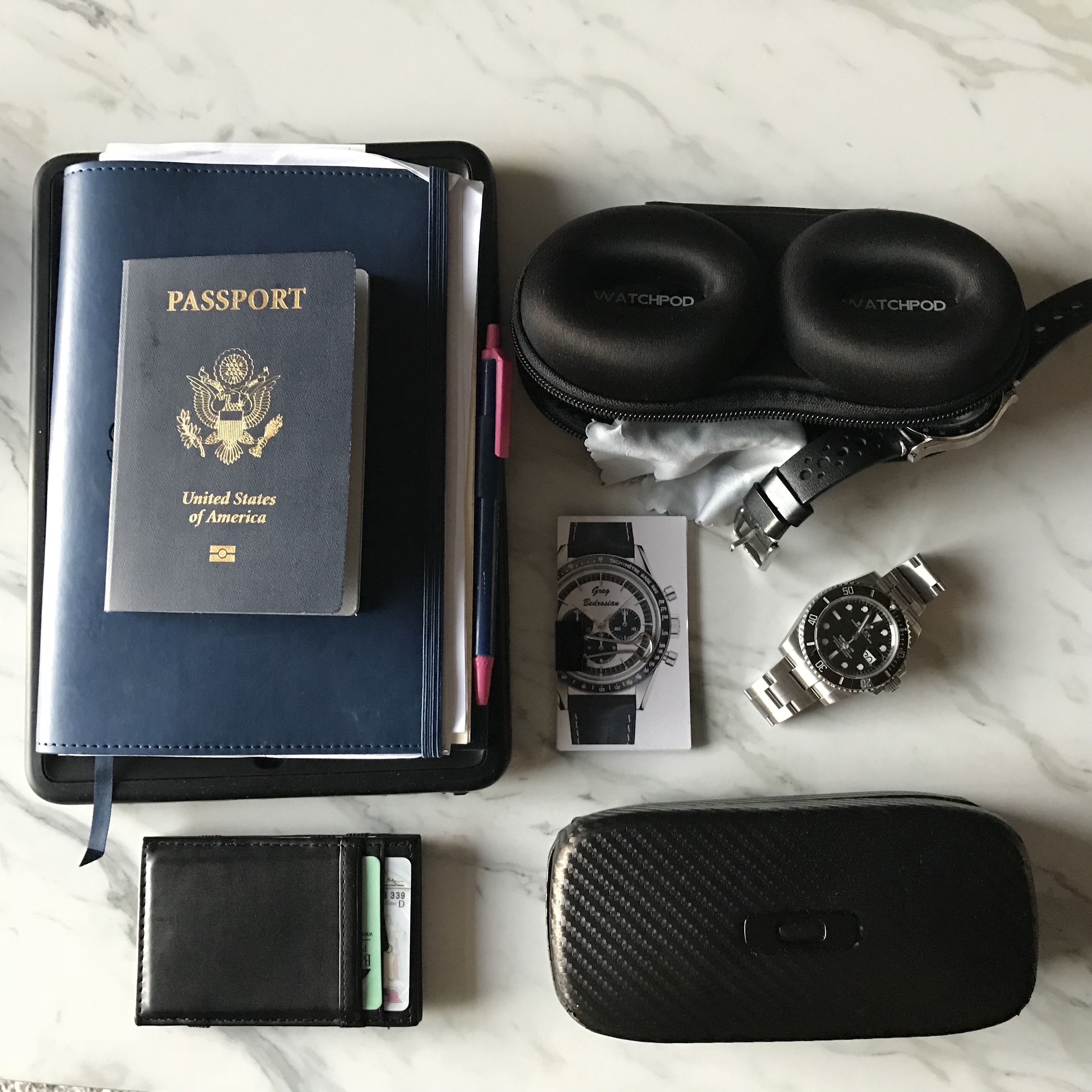
Choosing The Timepiece(s) You’re Traveling With
This might seem obvious, but it’s not that easy. Most of us own multiple watches. But as a general rule when traveling with watches, use the length of your trip as the basis for which watches to choose. Are you going to be gone for more than three nights? If that answer is “NO” bring only one watch. If the answer is “YES” then bring two. Never three.
Generally (for me) three nights or less falls into two categories: business trip or long-weekend getaway. Both call for traveling with watches of different varieties, but both still only call for one watch. If you think that you need more than one for three nights, you are overthinking it. If you must mix it up then take an extra strap. With three nights, you only settle into a routine at the end of your trip. The stress of traveling, unfamiliar accommodations, and fatigue can often lead to lost watches.
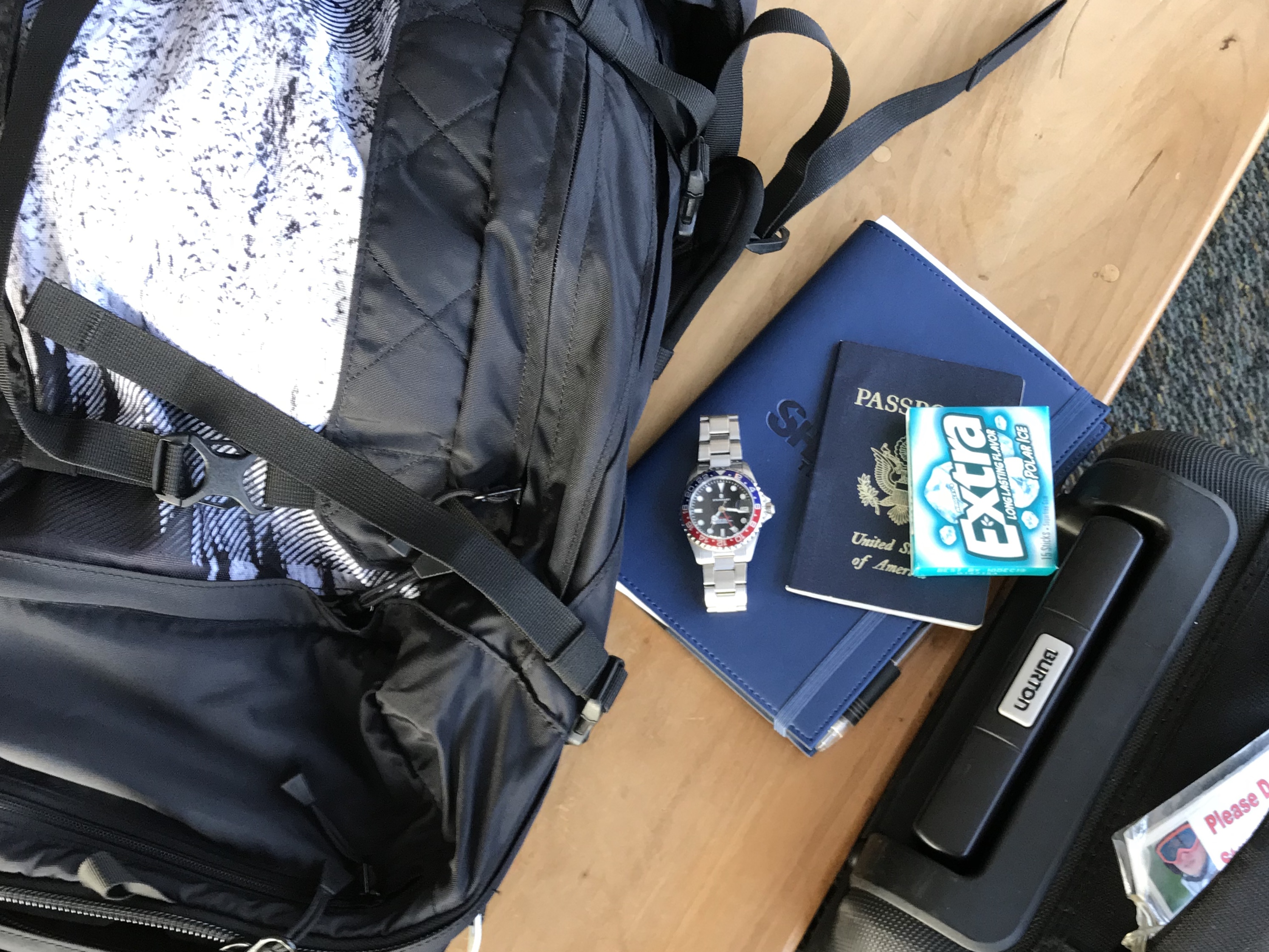
If you’re traveling with watches on a trip that’s going to be over three nights, bringing two watches is acceptable. Look at your planned activities and pick what would suit your needs the best. Are you spending the week at the beach? A vintage chronograph with a suede strap is obviously not a great first choice. But it could be a great second option for going out to dinner.
On an extended business trip, I always like to take a waterproof beater (I use “beater” as a term of endearment, not an insult) – think Seiko SKX or Casio G-Shock. Using the gym and pool at the hotel is a must after eating at restaurants all week. Swimming is a great option for exercise on a business trip because your bathing suit can dry and does not take a lot of space (as opposed to sweaty workout clothes). Make sure that one of the two watches you’re traveling with can handle the water.
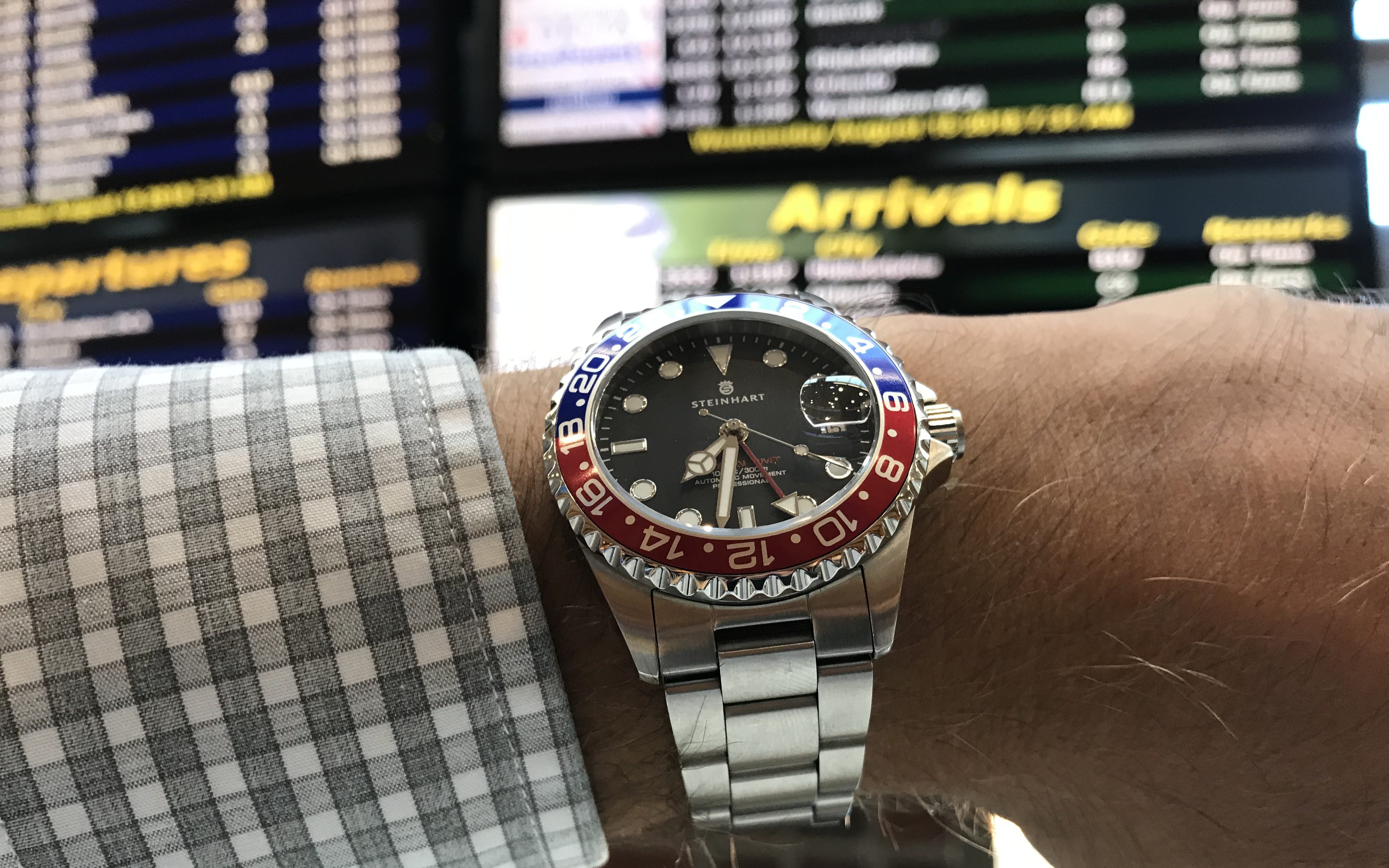
At the Airport
When talking about traveling with watches, the debate over taking your watch off or not at security is as long the TSA line itself. There is no official stance either way about watches on the TSA website except, “all bulky jewelry must be removed.” What does that even mean? Did the TSA mean to say, “six-digit reference Rolex owners must take their watch off, but five-digit reference owners may keep them on?”
I’ve seen watches dumped in the circular bowls with phones and wallets. I’ve also read on enthusiast forums many times that “they (the TSA) will have to take this watch off my cold dead wrist at the airport.” In reality, the requirement of taking your watch off or not at the security checkpoint is at the discretion of the TSA. You can request a “manual inspection,” but you could be subject to a cavity search. Seriously.
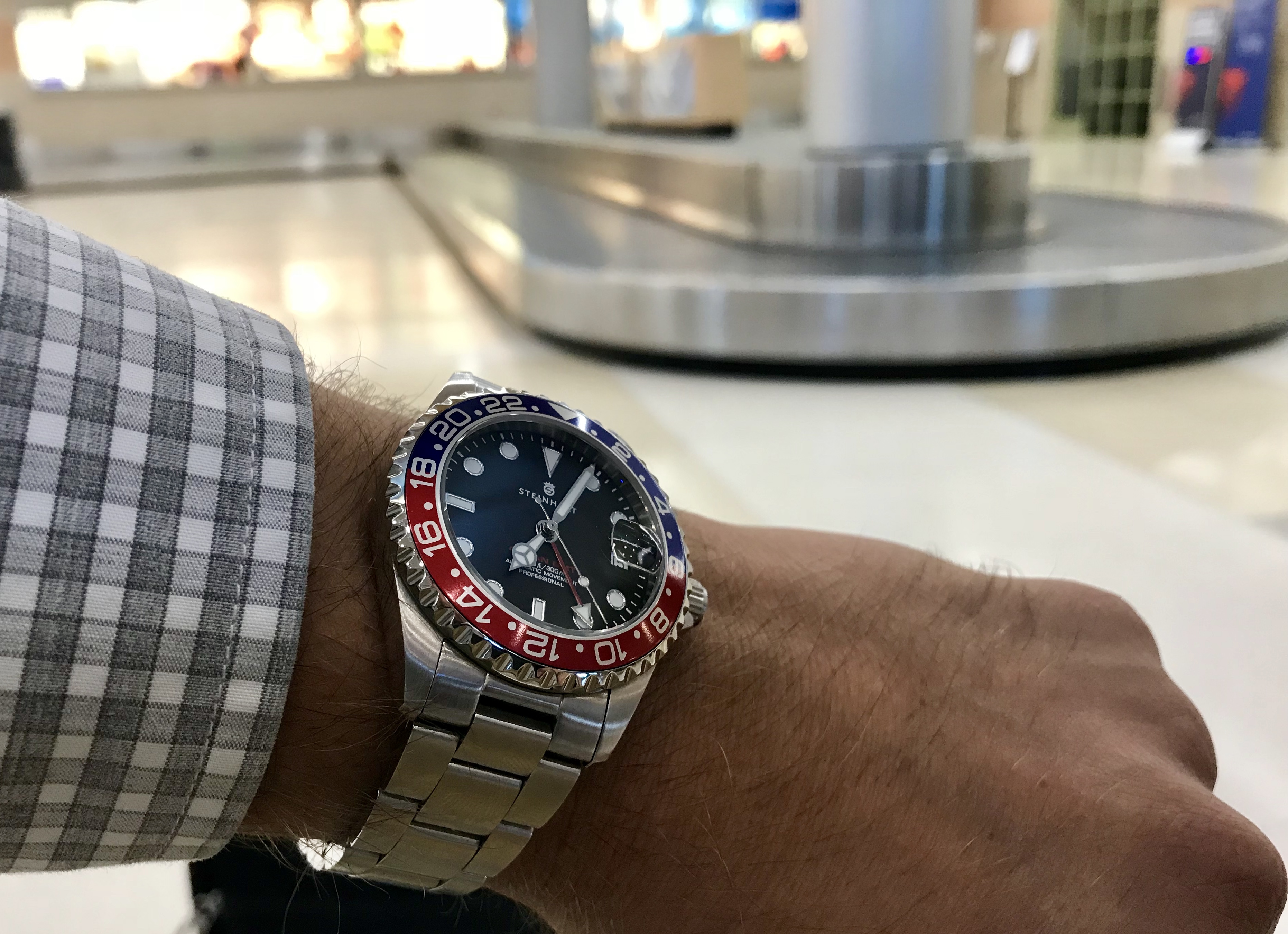
Keep an eye on the people in front of you as they go through the metal detectors and scanners. In my opinion when I’m traveling with watches the best option is to always leave your watch on. Be ready if you see TSA agents directing people to take their watches off. Never place a watch in a tray or bin. Have a plan.
I use a Burton [ak] 25L backpack as my “small personal item.” In the security line I always take off four things and put them in my bag. My belt, my phone, my wallet, and my watch. This backpack is meant for back-country snowboarding. It has all sorts of great protected pockets for stashing my EDC and travel essentials. The struggle of the security line scramble is real. Having a routine is critical to avoid accidental lost items.
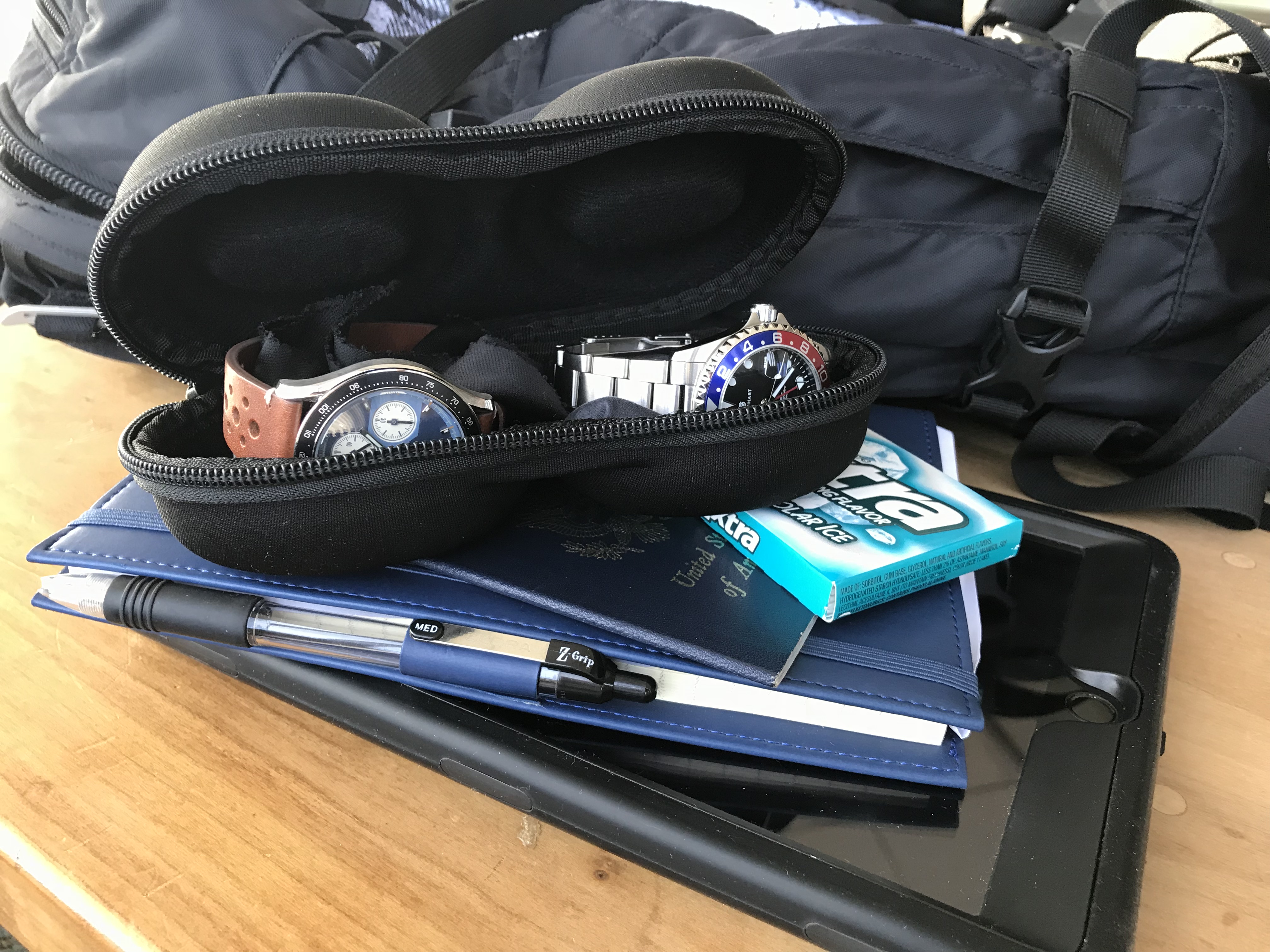
When you’re traveling with your watch having a case to protect the timepiece is crucial to the process. I like the WATCHPOD. It’s invaluable for instances like this. It’s small, light, inexpensive, and functional. It even comes with a little microfiber cloth. It’s much more protective than a watch roll. If you’re bringing more than one watch, opt for the Mc-Double version. If you require more padding, try the CASEBUDi triple.
After getting through the security line, the unpacking and reapplication of the belt, phone, wallet, and watch is just as important. Stick to your routine. Don’t let anyone hurry you to disrupt it. Get that watch back out your wrist ASAP. A watch is very hard to lose while you’re wearing it. Also, in all my time traveling with watches I’ve never had any watch gain or lose a second after it went through an X-ray machine or metal detector. The magnetic fields they create aren’t nearly as strong as other everyday items such as electric motors or computer speakers.
Road trip
When traveling with watches on a road trip, two watches should be fine. Always keep one watch and use the watch case for your backup. Have a dedicated spot to pack it in and never leave watches in the car.
The same rules as above apply. Travel with something nice paired with a lovable beater. But be appropriate – if you are backpack-camping in the Adirondacks for five days, leave the fluted Datejust at home and take the SKX.
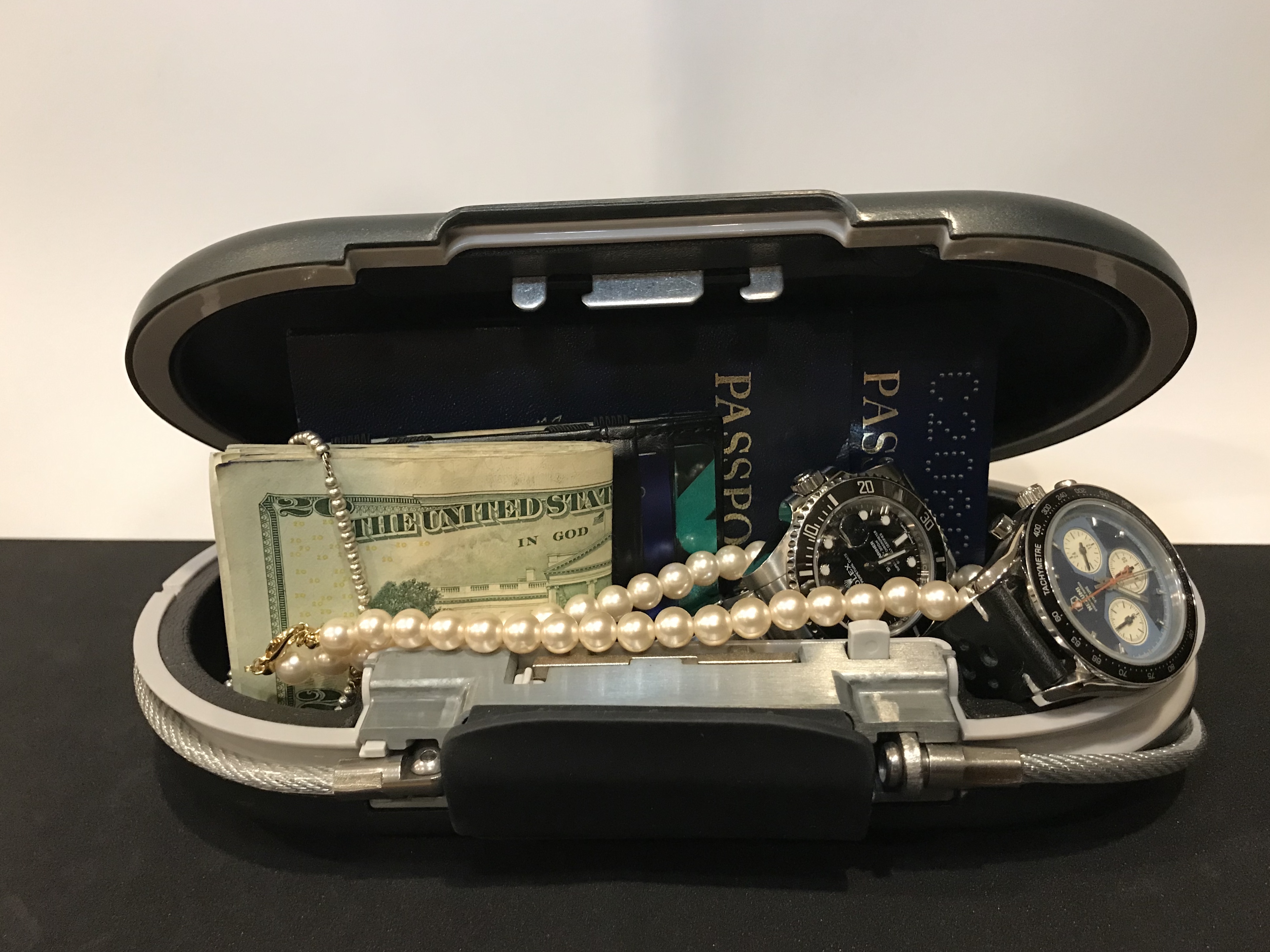
At your destination
Once you arrive at your destination pick a “watch spot”. Be aware of your surroundings and ask yourself the right questions. Will there be daily service in your hotel room? Are you sharing a large rental home with friends of friends? Is there really zero security risk at your grandma’s condo in Del Boca Vista (Phase III)?
Whatever your lodging situation is while traveling with watches, pick your watch spot based on your surroundings. Make sure it’s consistent. Where are you going to take it off and leave it? Consistency reduces the chance of loss. Just don’t it turn it into an horological pop-up shrine.
I sometimes use a portable safe. It’s not perfect, think of it as a deterrent. Master Lock makes an affordable option. I was traveling for business in Las Vegas and it was worth its weight in gold just for the peace of mind. I was relaxing at the MGM pool area during some downtime. Around 2pm the pool turned into a millennial version of MTV’s The Grind. It went from a private and quiet retreat to full on MTV Spring Break status within minutes.
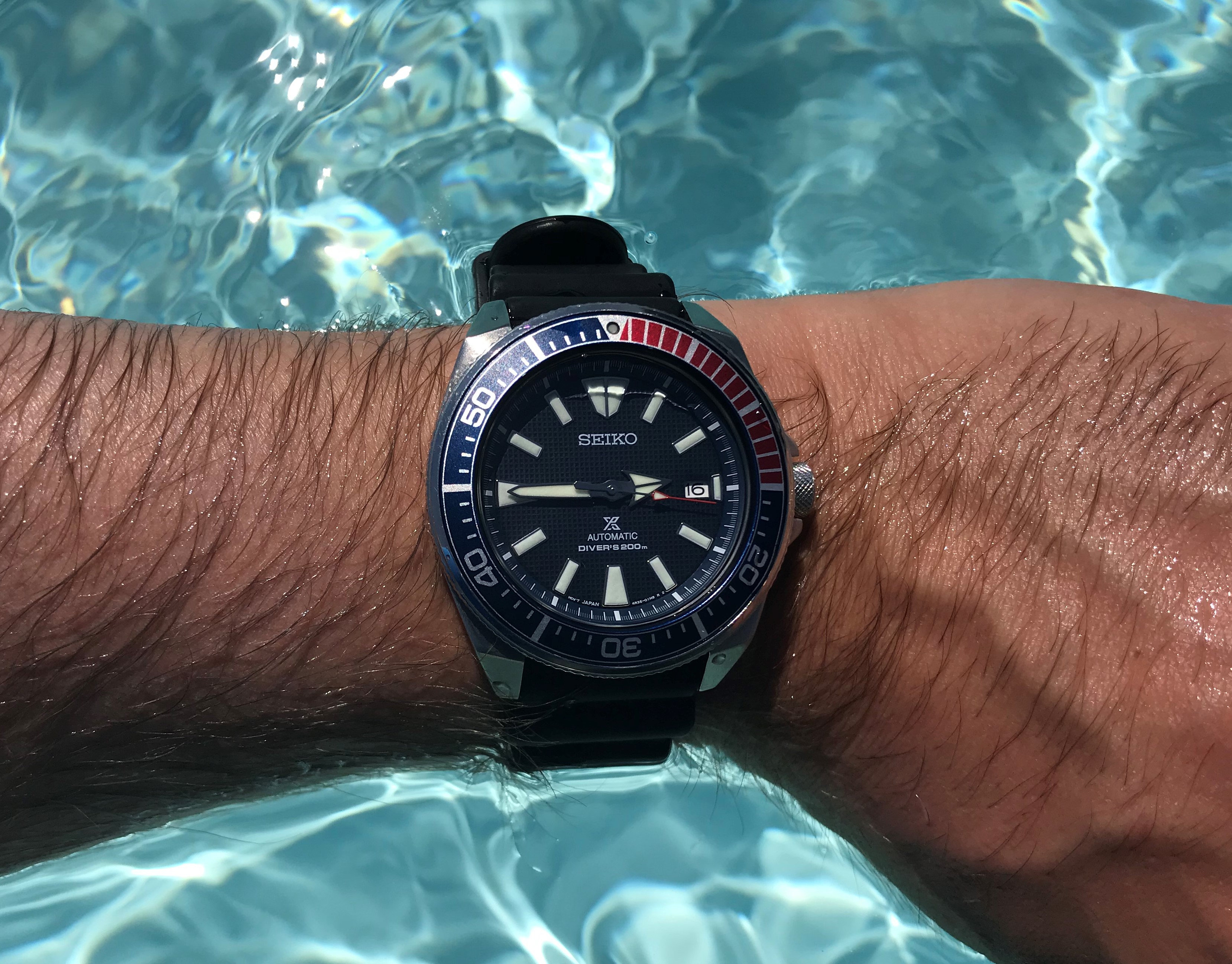
The temperature was over 95° and I needed to get into the water. I stupidly had a non-water friendly watch on my wrist. I was able to latch the portable lockbox to my backpack and the pool chair on the DL. My wallet, watch, and room keycard were locked inside of the Master Lock protective shell.
I set off wading in chest deep water to take a lap in the MGM’s lazy river. I halfass treaded water and swam around the chlorine, urine and Coors Light infused track away from my belongings. My mind was at ease. Yes, with effort you could get to my valuables. But the thief would make quite an awkward spectacle in the process.
Everything turned out fine. However, it was a rookie move on my part to not have a water-resistant watch with me in the first place. It was a pro move to have a personal safe.

Care and Maintenance
Hopefully while you’re traveling with watches, your journey takes you to exciting destinations. Grime, sweat, saltwater, and sunscreen are common contaminants. Most sport watches are easily cleaned with a little dish or hand soap. I have a cheap soft-bristled toothbrush that works great. If you are into minimalist packing, a little dish soap on your fingertips works well too.
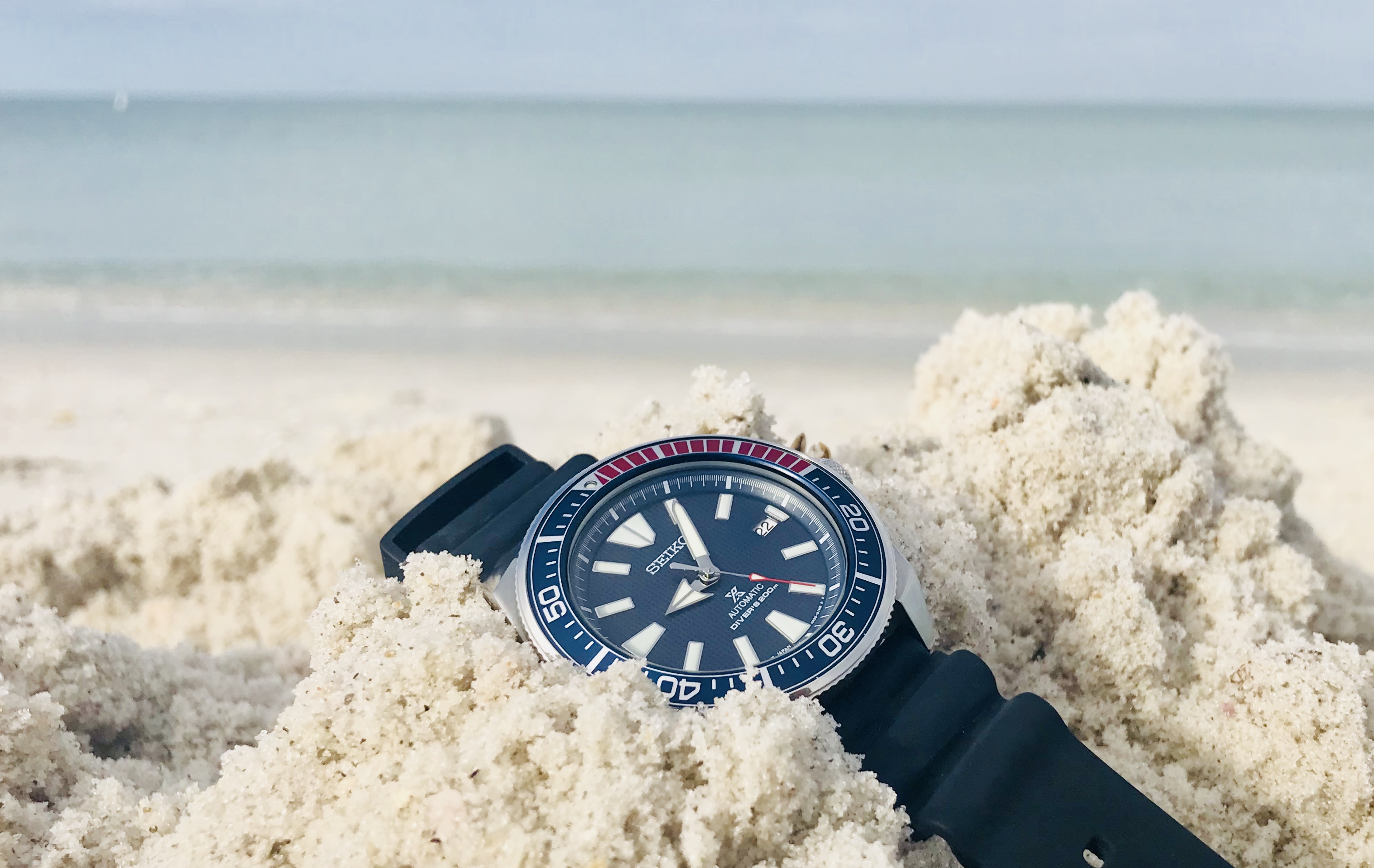
If you actually need the watch as a tool on you trip, make sure that it is in proper working order in advance. Don’t assume that you can risk your life 100ft below the waves on your Seiko turtle (no matter how cool that watch is). Spend the money and pressure test it if you’re thinking of taking it diving.
If you take your watch into the ocean, make sure to rinse after in tap water at a minimum. Saltwater and debris also get under the rotation bezel. A quick soak in some warm soppy water followed by a rise and dry will take care of this.
Insurance, theft, and robbery
If your watch is expensive or special, insure it. How do you decide to insure or not? Simple, ask yourself “would I be financially or emotionally devastated to lose this watch”? If you answer “yes” to either of those then insure it.
Be sure to ask the right questions of your insurance provider. Is “mysterious disappearance” included in my policy? Does each piece need to be itemized? Does the policy include reimbursement or replacement? Theft and robbery are different. Theft is a watch being stolen out of your hotel room while you’re out. Robbery is a much scarier situation.

Horological robbery happens when your watch is taken from you by force or the threat of force. This is the most import part of my article. Read it twice and let it sink in.
IF SOMEONE ATTEMPTS TO TAKE YOUR WATCH BY VIOLENCE OR THE THREAT OF VIOLENCE: YOU HAND THEM THE DAMN WATCH.
There is no watch that is worth risking harm to yourself or your traveling companions and / or family. I don’t care if it’s your grandfather’s Rolex. Hand it over if needed. Your grandfather is smarter than you and has seen some shit in his day. He would much rather you come back safely with a new duty-free Casio instead of seeing his Rolex still on the wrist of your corpse.
Remember that a Rolex is a target. The brand is easily recognized worldwide. That includes homage watches that are similar to the untrained eye. The likelihood of being robbed for a $400 Steinhart is higher than being targeted for a $20,000 Ressence.
The newest oldest-trick in the book involves a woman carrying a baby. She will approach you quickly fumbling the baby and trying to pass the infant too you. She pretends to drop the child. You reflexively reach out to stop the baby from falling. As you grab the baby she makes a scene to try and get the baby back.
This forces you into panic mode awkwardly half-holding this poor infant that isn’t yours in the middle of the street. As that happens, she puts her hands under the baby to take it back. Spoiler alert: she is also simultaneously removing your watch under the baby’s blanket. Then poof! She’s gone with your watch and maybe more.
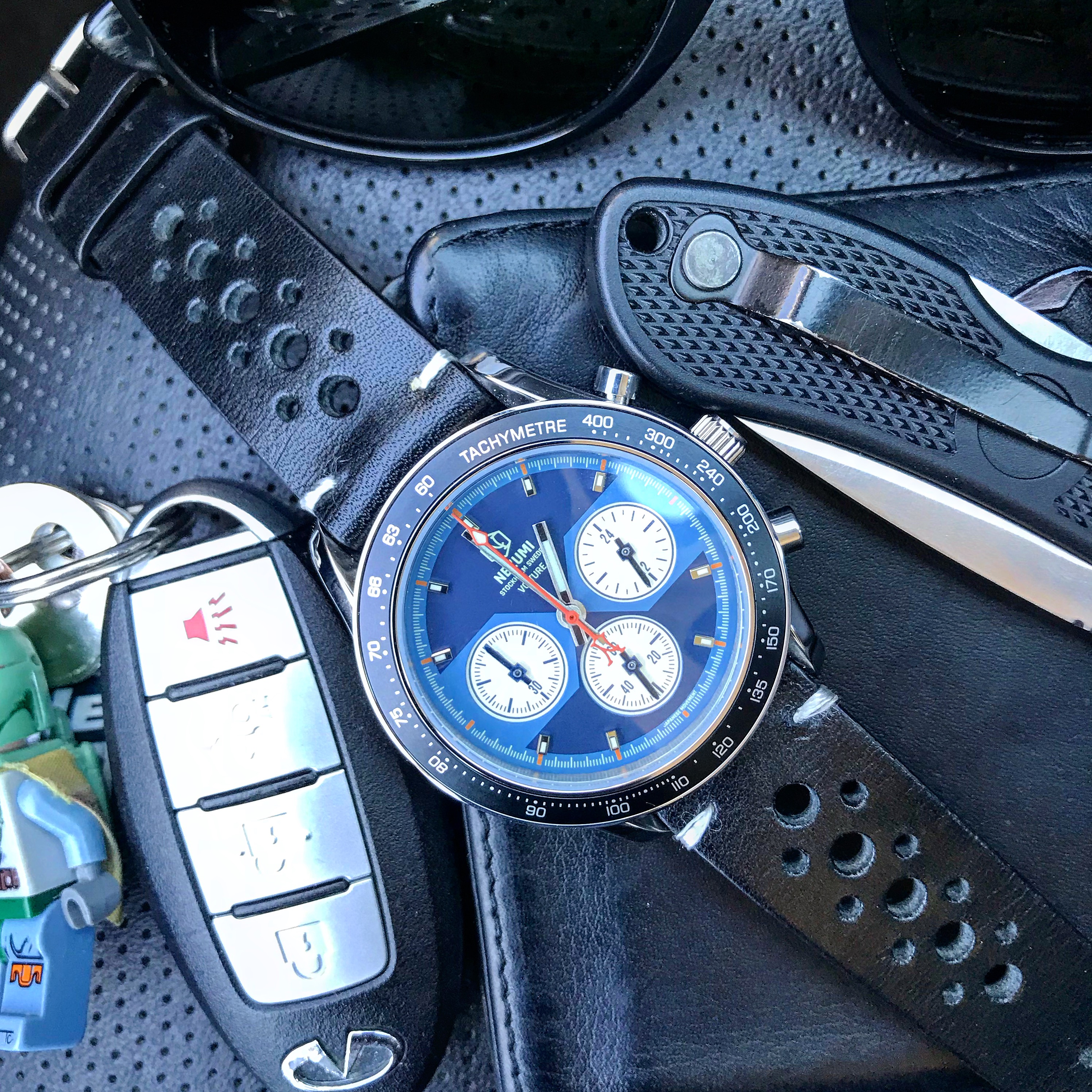
Other considerations
You might have been gifted a watch that may not be your favorite. If you’re going to see the person that gave the watch to you on the trip, make sure to wear it. Or at least wear it for a few hours when you see that person and make a point to thank them. Maybe you could bring that person a watch as a gift to reciprocate? It can also be fun to temporarily trade with a friend or sibling.
Conclusion
A watch is an important part in building memories while traveling. It can also be a comforting constant in an unfamiliar area. Please use your head and be appropriate with your selections.
Safe travels!
We would love to hear your watch travel stories and tips in the comments below.
Post Follow Up: Kaz’s Thoughts on Traveling with Watches
Greg’s piece above makes so many good points but there’s one in particular that resonates with me. Over the past few years I’ve done a lot of traveling with my wife and for me the best part has always been choosing which watches to travel with. What I noticed is that I would pack way more watches than I actually needed simply because I would create fake scenarios in my mind where I thought that a specific watch would be appropriate.
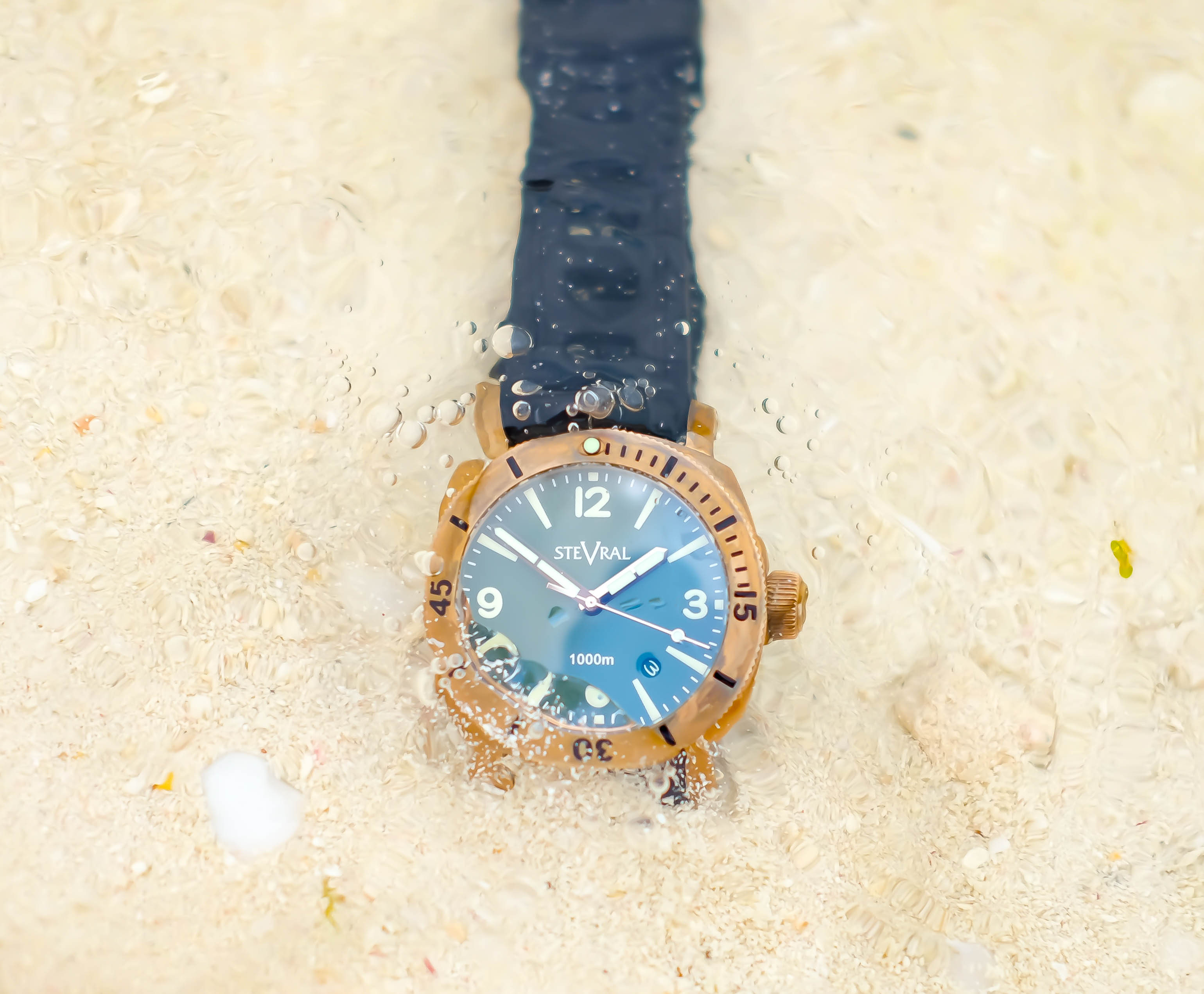
The result of me packing all these watches is that I actually only ever really ended up wearing two of them basically every time. It always ended up being a dress watch and a sport watch (usually my Seiko Sumo – exception below). So as you’re getting your perspective around traveling with watches, bear that in mind.
I did want to bring up something fun I discovered on one trip. When you’re traveling with watches, it can often be an interesting opportunity to pack something that you may not wear very often. Sometimes a new setting and situation can help you get good perspective on a piece that doesn’t always see wrist time. For example I was on the fence for a long time about the Stevral Bronze Moray I added to the collection. It was fun but once the honeymoon phase was over, I didn’t feel like I had really bonded with the piece.
So it didn’t see much wrist time. Around then we were planning for our annual Disney Cruise and I thought it’d be an interesting opportunity to bring the watch along and force myself to spend time with it outside my normal routine. Maybe that would help me get perspective on my feelings for the piece.
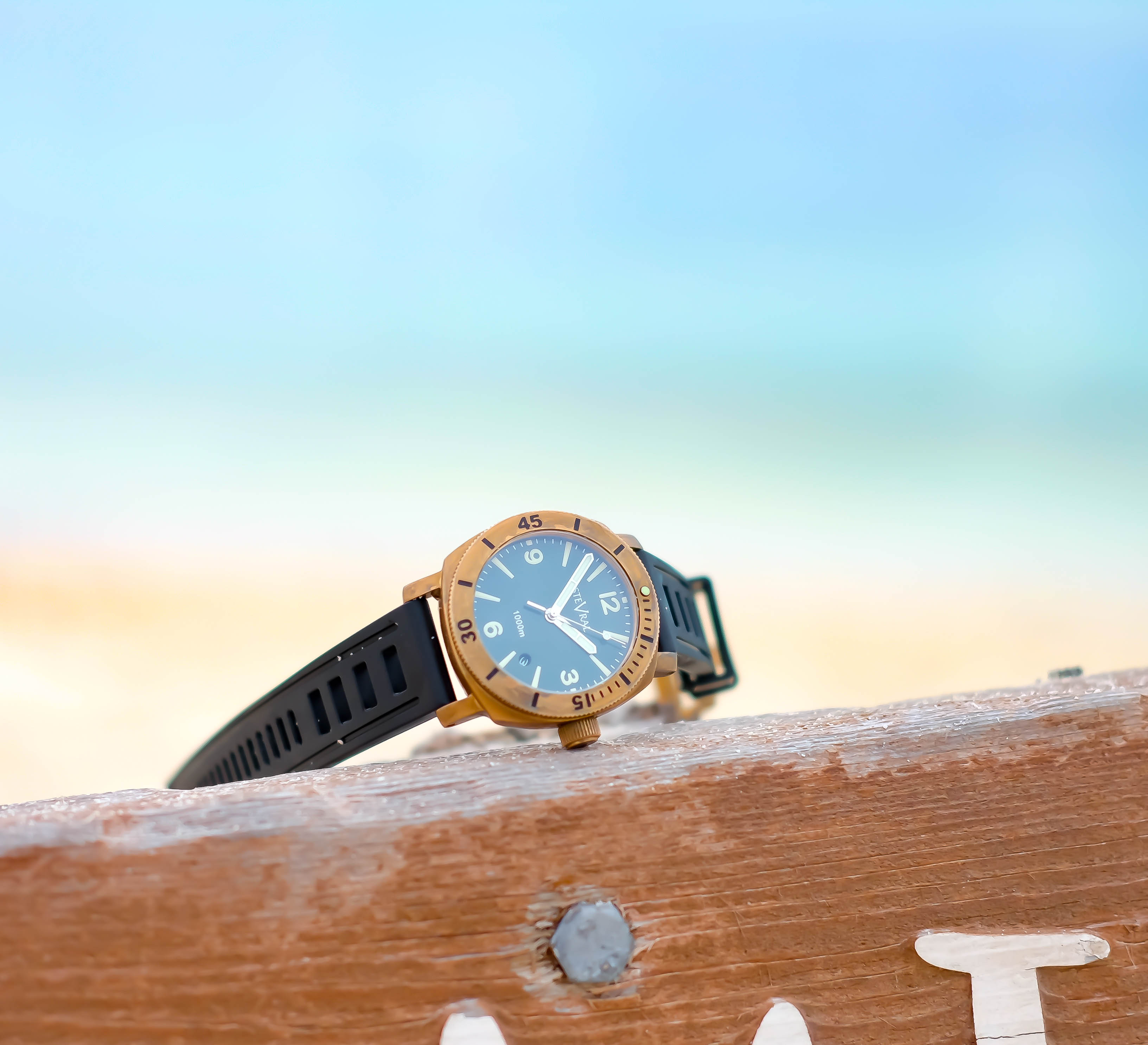
It definitely did. I had the watch during my time on Castaway Cay while I was on the beach and hanging out in the ocean. I got some fun shots and I certainly had a great time getting the watch wet. But using that traveling opportunity helped me to realize that the Stevral Bronze Moray really wasn’t a practical watch for me. So I decided to let it go and I’m very happy I did. I wouldn’t have been able to have that clarity if it wasn’t for the opportunity to travel with the piece.
So in addition to the incredible info that Greg’s provided above, if you’re traveling soon and there’s something in your watch box that may be on the chopping block, bring it along. It can help you make the right choice.

Greg is a long-time watch lover based in upstate New York. Greg is a supply chain professional by day and private watch consultant by night. Greg brings his own style to the TBWS website as a contributor by blending bits of humor into technical assessments. You can follow his cycling and snowboarding adventures on Instagram as he pursues the perfect 3-watch collection.

Great article. I travel a lot for work and often wear my Rolex 16710. The GMT functionality is great but one thing I’ve come to learn, if you’re traveling for work consider the client(s) you will be meeting with. My Rolex has gotten adverse reactions at a couple of my client sites. I now always take into consideration who my audience will be when selecting a watch for business travel.
Ryan,
Thanks for reading! My advice: wear long sleeves. But yes, being appropriate is always a good call.
Great article and good insights.
Also good thoughts, Kaz.
I like to keep it minimalistic when traveling One watch, then I always k KW where it is and don’t have to worry.
Besides then I don’t have to make up my mind when to wear which watch.
Thanks and cheers from Germany
Daniel / @daniels_watches
Traveling with one watch, how liberating! Thanks for reading.
I’ve traveled to many places with my Tudor Heritage Ranger. I usually bring an army green and a leather NATO with me. A very under the radar watch for sure.
Hi Greg,
I’m new to watch collecting but took my citizen blue angels nighthawk on my first business trip to London from california. The dual time subdial and quickset date and hour made the transition b/w time zones so effortless and I think the nighthawk may beat out my other dressier favorite: a glycine combat sub for my go-to travel watch b/c the navy-yellow color is so versatile. Dress it up or down. Unless I have some nights out on the town on those 3+ day trips, the combat sub will probably stay at home. Thanks for giving me a rule of thumb for future travels!
Cheers,
Frank
My plan for avoiding TSA hassles is to travel with an inexpensive Casio, which has the added benefit that it can easily change time zones. I’ve recently done that while keeping some other watches in a travel case that stayed in my backpack. I agree that 2 watches should be enough for a trip, but I’d count the one I wear through security as the 3rd one.